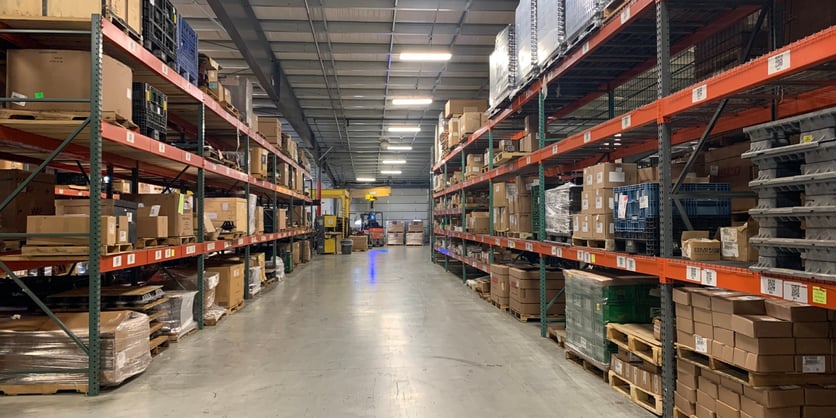What is nightmare fuel for machine shop production managers? Machine downtime.
Efficiency is always the goal, so when equipment is down, it can test the sanity of even the most experienced machine shop manager.
One solution is reliable production management. Upfront planning, with efficiency in mind, keeps things running smoothly to achieve peak uptime. Closely connected to that — and a crucial step — is being able to maximize CNC inventory, including having the right castings, components, tooling, and materials.
This checklist is your guide to leveraging your production management: implementing lean manufacturing processes, creating just-in-time inventory management, saving money, and more!
What is Production Management within a CNC Machine Shop?
Before we dive into the checklist, let’s agree on the definition of production management, specifically how it applies to a modern CNC machine shop. With that top-of-mind, we can ask questions that form a reliable production management roadmap.
Think of production management as improving the coordination of raw materials, human resources, and equipment. Your shop’s workflow and department collaboration are unique, so you’ll need to ask the right questions to create an effective roadmap. Here are some to get you started:
- What’s the goal that needs to be achieved?
- What tasks are required to meet that goal?
- Is there a way to repeat certain processes to improve efficiency?
- What tasks don’t directly contribute to meeting that goal?
- What processes are followed simply because “that’s the way it’s always been done?”
- What tools could help get tasks done more efficiently?
- Considering company growth projections, what project management needs may be required in the next 2-5 years?
The answers will help you focus on refining your processes to elevate your productivity. It takes time and effort to roadmap the right production goals for your shop’s needs. Yet, when production management practices are implemented and tasks begin to flow together, the results are a whirlwind of time-saving day-to-day operations, efficient communications, and profit boosting.
Inventory Management Checklist #1: Schedule Wisely
A little planning goes a long way, especially when it comes to CNC shop inventory. Determine the overall length of time required to complete a job, including the necessary working hours needed. Scrutinize every hour, because any opportunity to minimize wasted time not only speeds the process flow, it reduces labor costs.
Proper scheduling also helps keep your deliveries accurate and on time. And, by preventing inaccuracies in both your project timelines and reporting, there’s a reduction in the working hours spent dealing with those errors.
Best of all, a streamlined process minimizes the need for backup stocks and work-in-process inventories.
One word of caution here (yet it applies to every point on the checklist): Change is good when a process is streamlined, but make sure every task is easy to implement. That can make the difference between your team loving a change and resisting it.
Inventory Management Checklist #2: Optimize Your Workforce
Speaking of scheduling projects, you know how critical it is that the number of scheduled employees matches the workload each shift. Too much labor = too much inventory; not enough = projects are incomplete. Inventory optimization relies on your available workforce.
It’s challenging for CNC machine shop production managers to meet expectations without a clear idea of their team’s capacity to take on work. When new project requests are backed by solid workload information, the team can confidently manage new work and reliably hit deadlines.
Also, an optimized staff is aware that they’re each being held accountable for their work. No one wants to be the weakest link in the chain, and knowing that the team’s success depends on each person delivering expectations is motivating.
Communication is key to an engaged and flexible team. A workforce needs to be properly informed of changes well before they’re implemented, whether that’s a new process, workflow, software, or tool. Explain the productivity benefits to the team and encourage feedback. You’ll see easier adoption of changes, less resistance, and fewer struggles.
Inventory Management Checklist #3: Embrace Lean Manufacturing
Taking a lean production management approach benefits a shop’s inventory by keeping the overall focus on efficiency. While some may see “lean manufacturing” and imagine an involved and complex process, it’s really numerous minor changes that fit together in a streamlined process.
The main investment is dedicating employee time to brainstorm ideas that cut waste. If a task costs money to execute without adding value to the process, it’s eliminated. Implementing just a few of those can skyrocket inventory efficiency.
Think of Step #3 as mirroring design for manufacturing (DFM), which merges product design and its production method. The end goal is always to reduce effort and costs by simplifying and optimizing the process.
Inventory Management Checklist #4: Evaluate and Adjust
What you want to happen and what’s actually possible are likely two different things. That’s okay. You just need to objectively assess how your processes are affecting your CNC machine shop’s inventory and take steps to improve them. Expect to check your on-hand stock regularly and adjust accordingly.
Well-executed just-in-time inventory management can reduce the stress (and costs) of running out of product or failing to deliver on a big order, disappointing your customers and damaging your relationship. On the other hand, holding too much inventory can limit your working capital and jeopardize your bottom line.
Finding the best of both worlds (often a tricky balancing act) is the goal of just-in-time inventory management. Ordering stock at the perfect time — just close enough to when the product is needed — prevents stock from tying up cash flow. Targeting your work ahead for a period as short as two weeks keeps stock low while providing a buffer to keep customers happy when dealing with the reality of production issues.
Inventory Management Checklist #5: Look to Technology
When you hear “machine shop” and “technology” in the same sentence, your mind may first jump to automated robots and artificial intelligence (AI), which are smart ways to enhance processes.
However, production management software that resolves human inefficiencies, including regularly notifying the team of changes or responsibilities, can make a huge difference in efficiency.
This software is also the perfect way to introduce automated processes on the shop floor or within inventory control. Your employees who don’t take to change as easily as others know that software is supporting a new process’s smooth transition.
What digital production management software systems help maximize CNC machine shop inventory and save money?
- Enterprise Resource Planning (ERP) — Machine shops love having one source, a single system, for controlling operations, logistics, and inventory. An ERP provides accurate inventory data — from tracking turnover to surplus management to inventory organization — so the shop manager can make smarter decisions
- Internet of Things (IoT) — Shop managers get visibility into their inventory like never before when using an IoT system. Real-time updates on inventory items’ locations, statuses, and movements allow machine shops to monitor inventory from anywhere by using a smartphone or a laptop. Plus, machine learning can help predict the amount of raw materials needed for a production run
- Manufacturing Execution System (MES) — When shop floor information is made available to the entire machine shop, those responsible for different tasks can respond quicker to changing situations and conditions. In addition, labor/downtime, tooling, scrap, and other costs are captured immediately from the shop floor as they happen
Remember “just-in-time inventory management” earlier? Some shops carry “just-in-case inventory” to cover unexpected needs. Yet, because an MES constantly updates inventory records, your purchasing, manufacturing, and scheduling staff knows how much material is actually on hand, so additional inventory isn’t necessary.
Handle Current Jobs and be Ready for Future Ones
Every CNC machine shop is different. Different equipment, different workforce, different processes, different customers. Yet, one thing can be beneficial for any shop: the process of reviewing this 5-step checklist and highlighting inefficiencies in current systems can be helpful.
And, even if introducing a new software system for CNC machine shop inventory management isn’t in the cards now, preparing for one is a step in the right direction.
Once you do have a new and reliable project management tool in place, you can begin to grow with confidence. Your team will get in a groove of using the shop inventory software, communicating effectively, and hitting deadlines with minimal stress. At that point, you can expand on your foundation and introduce new processes for long-term inventory success.
A final word on CNC machine shop inventory management. Whatever steps you take, your people need to work in a comfortable environment that allows them to thrive without concerns for their safety: qualified people on the equipment, rules and regulations understood, scheduled maintenance followed, correct handling of hazardous materials, and robotics that remove injury possibilities.
If any step in this production management checklist reduces your nightmare fuel, we’re thrilled. Now, learn more about the CNC machining industry. Click below to access our guide, which explains a lot!




